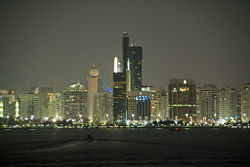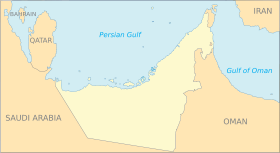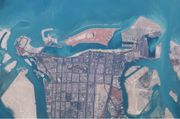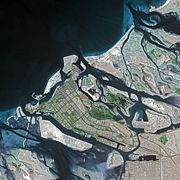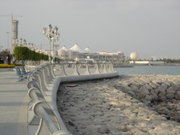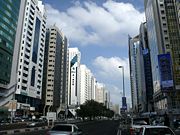Abu Dhabi (city)
2008/9 Schools Wikipedia Selection. Related subjects: Middle Eastern Countries
| Abu Dhabi أبو ظبي |
|||
| — city — | |||
| City of Abu Dhabi | |||
| Abu Dhabi's skyline from Marina Mall | |||
|
|||
| Location of Abu Dhabi in the UAE | |||
| Coordinates: | |||
|---|---|---|---|
| Emirate | Abu Dhabi | ||
| Government | |||
| - Sheikh | Khalifa bin Zayed Al Nahyan | ||
| Area | |||
| - Total | 67,340 km² (26,000.1 sq mi) | ||
| Population (2007) | |||
| - Total | 1,463,491 | ||
| - Density | 293.94/km² (761.3/sq mi) | ||
Abu Dhabi (Arabic: أبو ظبي transliteration: abū ẓābī, literally Father of gazelle) is the capital and second most populous city in the United Arab Emirates (UAE), after Dubai. It is also the seat of government of the emirate of Abu Dhabi. Abu Dhabi lies on a T-shaped island jutting into the Persian Gulf from the central western coast. Approximately 1,000,000 people live in Abu Dhabi as of 2008, of whom 80% were expatriates. One of the world's largest producers of oil, Abu Dhabi has actively attempted to diversify its economy in recent years through investments in financial services and tourism. Abu Dhabi is ruled by Khalifa bin Zayed Al Nahyan, who is also the President of the UAE.
History
Parts of Abu Dhabi were settled in the 3rd millennium BC and its early history fits the nomadic herding and fishing pattern typical of the broader region. Modern Abu Dhabi traces its origins to the rise of an important tribal confederation, the Bani Yas, in the late 18th century, which also subsequently assumed control of the town of Dubai. In the 19th century the Dubai and Abu Dhabi branches parted ways.
Into the mid-20th century, the economy of Abu Dhabi continued to be sustained mainly by camel herding, production of dates and vegetables at the inland oases of Al Ain and Liwa Oasis, and fishing and pearl diving off the coast of Abu Dhabi city, which was occupied mainly during the summer months. Most dwellings in Abu Dhabi city were, at this time constructed of palm fronds (barasti), with the wealthier families occupying mud huts. The growth of the cultured pearl industry in the first half of the twentieth century created hardship for residents of Abu Dhabi as pearls represented the largest export and main source of cash earnings.
In 1939, Sheikh Shakhbut Bin-Sultan Al Nahyan granted petroleum concessions, and oil was first found in 1958. At first, oil money had a marginal impact. A few lowrise concrete buildings were erected, and the first paved road was completed in 1961, but Sheikh Shakbut, uncertain whether the new oil royalties would last, took a cautious approach, preferring to save the revenue rather than investing it in development. His brother, Zayed bin Sultan Al Nahyan, saw that oil wealth had the potential to transform Abu Dhabi. The ruling Al Nahyan family decided that Sheikh Zayed should replace his brother as ruler and carry out his vision of developing the country. On August 6, 1966, with the assistance of the British, Sheikh Zayed became the new ruler.
With the announcement by the UK in 1968 that it would withdraw from the Persian Gulf area by 1971, Sheikh Zayed became the main driving force behind the formation of the United Arab Emirates.
After the Emirates gained independence in 1971, oil wealth continued to flow to the area and traditional mud-brick huts were rapidly replaced with banks, boutiques and modern highrises.
Location
The emirate of Abu Dhabi is located in the oil-rich and strategic United Arab Emirates and is an active member of the Gulf Co-operation Council (GCC). It borders with the Kingdom of Saudi Arabia (south) and the Sultanate of Oman (east). The emirate borders the emirate of Dubai to its northeast. In the north is the Persian Gulf.
Abu Dhabi city is on an island located less than a quarter-kilometer from the mainland and is joined to the mainland by the Maqta and Mussafah Bridges. A third bridge, designed by Zaha Hadid, is currently under construction. Bridges connecting to Reem Island and Saadiyat Island are also under construction.
Most of Abu Dhabi is located on the island itself, but it has many suburbs on the mainland for example: the Khalifa Cities, Between Two Bridges, and Mussafah Residential.
Language and literature
The majority of the inhabitants of Abu Dhabi are expatriate workers from India, Pakistan, Egypt, Bangladesh, Sri Lanka, Philippines, the United Kingdom and various countries from across the Arab world. Consequently, English, Tagalog, Tigrinya, Amharic, Bengali, and Urdu are widely spoken. Apart from Hindi, many Indian expatriates also contribute other South Asian languages to the cultural milieu, including Malayalam, widely spoken in Kerala.
The native-born population are Arabic-speaking Persian Gulf Arabs who are part of a clan-based society. The Al Nahyan family, part of the al-Falah branch of the Bani Yas clan, rules the emirate and has a central place in society.
Current ruler
Sheikh Khalifa bin Zayed Al Nahyan is the hereditary ruler of Abu Dhabi (UAE). He is the son of Sheikh Zayed Al Nahyan, the first president of the United Arab Emirates.
Economy
Abu Dhabi is the wealthiest emirate of the UAE in terms of Gross Domestic Product (GDP) and per capita income. The average net worth for Abu Dhabi's 420,000 citizens is AED 62 million (US$ 17 million), and more than $1 trillion is invested worldwide in this city alone. The GDP per capita also reached $63,000 , which is far above the average income of the United Arab Emirates and which ranks third in the world after Luxembourg and Norway. Abu Dhabi is also planning many future projects sharing with the Cooperation Council for the Arab States of the Gulf (GCC) and taking 29% of all the GCC future plannings. The United Arab Emirates is a fast-growing economy: in 2006 the per capita income grew by 9%, providing a GDP per capita of $49,700 and ranking third in the world at Purchasing power parity. Abu Dhabi plays a large role in the world economy. Abu Dhabi's sovereign wealth fund, the Abu Dhabi Investment Authority (ADIA), currently estimated at US$ 875 billion, is the world's wealthiest soverign fund, in terms of total asset value.
Postage stamps
Climate
Sunny/blue skies can be expected throughout the year. The months of April through September are generally hot and humid with maximum temperatures averaging above 40 °C (104°F). During this time, sandstorms also occur intermittently, in some cases reducing visibility down to a few meters.
The weather is cooler from November to March. This period also sees dense fog on some days. The oasis city of Al Ain, about 150 km away, bordering Oman, regularly records the highest summer temperatures in the country, however the dry desert air and cooler evenings make it a traditional retreat from the intense summer heat and year round humidity of the capital city.
Transport
Abu Dhabi International Airport (AUH) serves this city. The local time is GMT + 4 hours. Private vehicles and taxis are the primary means of transportation in the city. There is a 2 AED pick-up fee plus 0.50 AED per km. Public buses are available, but are not widely used. The fare starts at 2 AED and it is rare for the fare to go above 6 AED during intracity travel. There are bus routes to nearby towns such as Baniyas, Habashan and Al Ain, among others. A service to Dubai (about 160 km away) started in 2005.
City planning
The city was planned in the 1970s for an estimated maximum population of 600,000. In accordance with what was considered to be ideal urban planning at the time, the city has wide grid-pattern roads, and high-density tower blocks.
On the northerly end of the island, where the population density is highest, the main streets are lined with 20-story towers. Inside this rectangle of towers is a normal grid pattern of roads with lower density buildings (2 story villas or 6 story low-rise buildings).
Abu Dhabi city is a modern city with broad boulevards, tall office and apartment buildings, and busy shops. Principal thoroughfares are The Corniche, Airport Road, Sheikh Zayed Street, Hamdan Street and Khalifa Street.
Abu Dhabi city is known in the region for its greenery; the former desert strip today includes numerous parks and gardens.
Mail is generally delivered to post-office boxes only; however, there is door-to-door delivery for commercial organizations. There are many parks (or public gardens) throughout the city. Entrance is usually free for children, however there is often an entry fee for adults. The city has a "Corniche," or seaside promenade, about 7 kilometres (4.3 mi) in length, with gardens, playgrounds, and a BMX/Skateboard ring.
The design of the inner city roads and main roads are quite organised. All horizontal streets (starting from Corniche street, St. # 1) are odd and the verticals are evenly numbered. So Corniche is Street #1, Khalifa is Street # 3, Hamdan is Street # 5, and so on. While Salam Street is St # 8.
Abu Dhabi has since brought former Vancouver city planner Larry Beasley onboard to help oversee their urban development.
Planning problems
- The city's population far surpasses the original estimated maximum population when it was designed. This causes traffic congestion, a shortage of car parking spaces, and overcrowding.
- Although there is an addressing system for the city, it is not widely used, and so causes problems in describing building locations. This means directions must often be given based on nearby landmarks.
- The lack of a comprehensive, reliable, and frequent public transport system has led to a near complete dependence on private cars and taxis as a means of transport. However, plans to build light railway connections between the centre and the airport, and onwards towards Dubai, have been announced.
- Grid-pattern roads mean a public transportation system is difficult to implement without requiring a moderate amount of walking, which could be a large deterrent to usage.
Future development
New developments on islands surrounding the city plan to increase the population of the city by up to 2,600,000.
The government of Abu Dhabi has announced plans to fund a campus for New York University, the first of its kind to be established by a major US research university outside of the United States. The university is expected to receive students by 2010.
Major projects
- Qasr al-Hosn and Cultural Foundation
- Saadiyat Island ("Island of Happiness")
- Al Lulu Island
- Reem Island
- Al Raha
- Abu Dhabi Grand Prix circuit on Yas Island
- Masdar City
- New York University in Abu Dhabi
Culture and the arts
Abu Dhabi is trying to position itself as the "Cultural hub" of the Middle East, taking this mantle from such neighboring cities as Beirut and Cairo. It is home to a number of cultural institutions including the Cultural Foundation and the National Theatre. The Cultural Foundation is home to the UAE Public Library and Cultural Centre. Various cultural societies such as the Abu Dhabi Classical Music Society have a strong and visible following in the city. The recently launched Emirates Foundation makes grants in support of the arts, as well as to advance science and technology, education, environmental protection and social development. The International Prize for Arabic Fiction (IPAF) will be based in Abu Dhabi.
- The creation of a major "up-scale cultural district" on Abu Dhabi's Saadiyat Island has begun with the groundwork for a US$200 million Guggenheim Museum. The Frank Gehry-designed museum will display a "prestige collection" of modernist and contemporary art and is scheduled for completion in 2011. Upon completion, it is expected to be the largest exponent of the prestigious Guggenheim Museums. In addition, there will be three further cultural focal points : The Performing Arts Centre, The Sheikh Zayed National Museum and The Maritime Museum.
Education
Abu Dhabi is home to several international and local private schools and universities.
Primary and secondary schools
- GEMS American Academy – Abu Dhabi
- Abu Dhabi Grammar School (Canada)
- Abu Dhabi Indian School
- Abu Dhabi International School
- Al Manara School
- Al Nahda National Schools
- Al Noor Indian Islamic School
- Al Worood Academy
- Al Raha International School
- Asian International Private School
- Canadian International School (CIS)
- Emirates Private School
- Landus Public School
- Lycée Louis Massignon (École Française)
- The American Community School of Abu Dhabi
- The American International School in Abu Dhabi
- The British School - Al Khubairat
- The Cambridge High School
- First Steps School Nursery
- The German School Abu Dhabi
- Indian Islahi Islamic School
- International Academic School, Abu Dhabi
- International Community School
- International School of Choueifat, Abu Dhabi
- Islamia English School
- Our Own English High School
- Sheikh Khalifa Bin Zayed Arab Pakistani School
- The Sherwood Academy
- St. Joseph's School
- Noah's Ark Nursery
- Little Flower (P) School
- Umm Amar Secondary School
- Wisdom High School
- Sunrise English Private School
Skill Development Institutes
- UCMAS – Universal Concept of Mental Arithmetic System
- Noah's Ark Art & Music Institute
Colleges and universities
- Abu Dhabi University
- Al Khawarizmi International College
- Higher Colleges of Technology
- Sheikh Khalifa Bin Zayed Bangladesh Islamia School and College , Abu Dhabi
- Paris-Sorbonne University in Abu Dhabi
- Zayed University
- New York University in Abu Dhabi (Under Construction)
- Masdar Institute of Science and Technology
- Petroleum Institute
